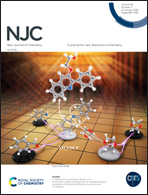MXene-supported copper-molybdenum sulfide nanostructures as catalysts for hydrogen evolution†
Abstract
The development of efficient and low-cost sustainable electrocatalytic hydrogen precipitation materials is an effective way to support the reduction of fossil fuel use. In recent years, in order to overcome the problem of the poor electrical conductivity of transition metal chalcogenides (TMCs), carbon-based materials and the MXene family have become popular TMC carriers. In this work, Cu2MoS4/Ti3C2Tx-30% materials with a special structure were synthesized for the first time via a simple and friendly solvothermal method. We successfully grew Cu2MoS4in situ on a MXene (Ti3C2Tx) via solvent heating, and Cu2MoS4/Ti3C2Tx-30% was bonded together by electrostatic adsorption to form a special structure. Its overpotential is 103 mV lower than that of pure Cu2MoS4 at a current density of 10 mA cm−2 in an acidic medium (0.5 M H2SO4). At the same time, under the same conditions, the Tafel slope is 37 mV dec−1 lower than that of pure Cu2MoS4. Critically, the heterostructure retains high catalytic activity within 20 h. All of this is attributed to the special structure of Cu2MoS4/Ti3C2Tx-30%, resulting in increased conductivity, electrochemically active surface area (ECSA), and stability. This provides new ideas for future discoveries relating to the synthesis of non-precious transition metal two-dimensional composites.



 Please wait while we load your content...
Please wait while we load your content...